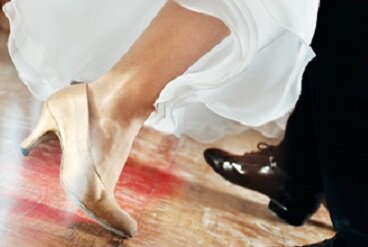How to Walk in Standard 
7 September 2016
In Latin you flick the feet and style the arms, but in Standard, it's all about walking. Alex Moore said Quickstep is comprised of just Walks and Chasses, and Foxtrot of Walks and Three Steps. In Waltz and Viennese Waltz, the first beat is always the strongest, and that is the beat the Walk occurs, and if you haven't practiced Tango Walks a thousand times, you probably haven't been dancing that long. In Standard, it's all about walking. The problem is, walking in Standard is slightly different from walking on the street, but fear not, for this article will give you all the technical details of the Walk action in Standard.
Forward Walk
The Forward Walk is used in Waltz, Viennese Waltz, Foxtrot, and Quickstep. This Walk encompasses the technique for the Man's Step 1 of the Feather Step, for the Natural Turn or Reverse Turn in any dance but Tango, and for so many more figures. This is an in depth break down of a Right Foot Forward Walk. The Left Foot Walk would be the natural opposite.
| 1 | Commence standing with feet together, with knees slightly flexed and weight toward the Balls of the feet |
| 2 | Swing the Right leg forward from the hip, keeping the ball of the Right foot in contact with the floor |
| 3 | As soon as the Right foot fully passes the Left, commence to release the Heel of the Left foot from the floor |
| 4 | As the Right leg extends forward, the Flat of the foot comes in contact with the floor briefly, and then the contact moves to the Heel, pulling back the Toe |
| 5 | At the extent of the stride, weight will be distributed 50/50 between the Heel of the Right foot, with knee straight, and the Ball of the Left foot, with knee slightly flexed |
| 6 | Immediately lower the Right toe so the foot is flat |
| 7 | As weight is brought onto the Right foot, flex the Right knee and roll through the Left foot naturally from the Ball to the Toe |
| 8 | Draw the Left foot toward the Right foot, first with the Toe in contact with the floor, then the Ball, until it comes side by side with the Right foot |
N.B. Step 1 of a Natural Turn in Waltz is different from that of Quickstep or Foxtrot because of the lowering action, which is not described above.
Back Walk
The Back Walk is used in Waltz, Viennese Waltz, Foxtrot, and Quickstep. This Walk encompasses the technique for the Lady's Step 1 of the Feather Step, for the Natural Turn or Reverse Turn in any dance but Tango, and for so many more figures. This is an in depth break down of a Left Foot Back Walk. The Right Foot Walk would be the natural opposite.
| 1 | Commence standing with feet together, with knees slightly flexed and weight forward over the Balls of the feet |
| 2 | Move the Left leg back, with the Ball of the foot in contact with the floor |
| 3 | As soon as the Left foot fully passes the Right, commence to release the Toe of the Right foot from the floor |
| 4 | As the Left leg extends back, it will go from the Ball of the foot being in contact with the floor to the Toe, before placing weight and rolling back to the Ball |
| 5 | At the extend of the stride, weight will be distributed 50/50 between the Ball of the Left foot, with knee slightly flexed, and the Heel of the Right foot, with knee straight |
| 6 | Commence to lower the Left Heel gradually and with control |
| 7 | As weight is brought back onto the Left foot, flex the Left knee, continuing to lower the Left Heel gradually |
| 8 | Draw the Right Foot back toward the Left foot first with the Heel in contact with the floor, then the Ball, until it comes side by side with the Left foot, at which point the Left Heel will have just fully lowered |
There is a key difference between the Forward and Back Walk: whereas in the Forward Walk you should commence with weight toward the Balls of the feet, in the Back Walk you should commence with weight over the Balls of the feet. It is important when moving backward always to keep the weight forward, to avoid falling off balance.
Tango Walks
Tango Walks differ from the Walks used in the Swing Dances in seven primary ways.
| 1 | There is never any Rise or Fall |
| 2 | The knees are kept slightly flexed throughout |
| 3 | The LF Forward Walk and RF Back Walk are taken in CBMP, and The RF Forward Walk and LF Back Walk are taken with a Left Side Lead |
| 4 | Because of this, when going forward the Walks always curve slightly to the Left (when going Back, to the Right) |
| 5 | The feet are lifted and plopped onto the floor, as opposed to skimming the floor |
| 6 | The foot placement uses a sharp staccato action |
| 7 | The Man may choose not to release the Right Toe from the floor when dancing a Back Walk on the Left foot. |
To learn more about how Tango is different from the other four Ballroom dances, click here.